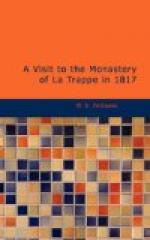[Illustration: MILL AUX CHEVRES.]
The whole history of this terrible war is filled with the noble devotion of heroic females. The chiefs were attended in the most sanguinary battles by ladies, who had themselves ornamented their standards with loyal and chivalrous emblems of the cause for which they were prepared to sacrifice themselves, and who were frequently seen rallying the broken troops, and falling, covered with wounds, by the hands of their enemies!
The annexed view of the Moulin aux Chevres, which is rendered interesting from the account given by Madame de la Roche-Jaquelin of the battle fought near it, will convey a tolerable idea of the scenery of the country.
The prodigious growth of the willow tree in Bretagne, is such as to claim the peculiar notice of travellers: here they attain a gigantic height, no where else to be seen. Batard, in his “Notices sur les Vegetaux” mentions one in the commune of Pommeraie in the arrondissement de Beaupreau, whose age was supposed to be nearly two thousand years. Within the Chateau at Clisson are some very old ones, but the finest I observed were at the Moulin aux Chevres.
CHAP. VI.
LIMITS AND GENERAL APPEARANCE OF LE BOCAGE. MODE OF WARFARE PRACTISED BY THE VENDEANS.
My opportunity of becoming acquainted with that singular district called Le Bocage, will be best understood by very briefly sketching my route through it. I traversed it, and the district called Le Loroux, by the route of Montaigne and Lege, and on my return I passed through Clisson, Vallet, and Loroux, along the banks of the Loire. By pursuing this route, I had every where the interesting opportunity of exploring the scene of that destructive warfare which had ravaged the towns and villages of this part of France.
At one period, the war of La Vendee extended to the north of the Loire, as far as Rennes, forming a triangle, the eastern point of which rested on the town of Angers. To the south of the Loire it spread nearly as far as la Rochelle; and as in this part also it extended nearly to Angers, the tract over which it spread its ravages formed nearly a square. The district called Loroux runs parallel with the Loire: Le Bocage, which occupies both districts, and the whole country south of that river, is comprehended under the general appellation of La Vendee. Under the old divisions of France Le Bocage formed part of the province of Poitou, and Le Loroux part of the provinces of Anjou and Bretagne: but when, at the revolution, France was divided into departments, these two districts were denominated La Vendee, Les deux Sevres, La Loire Inferieure, and Mayenne and Loire.




